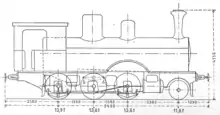Württemberg Fz
The Württenberg Fz was a class of nine 2-6-0T rack locomotives of the Royal Württemberg State Railways (Königlich Württembergischen Staats-Eisenbahnen, K.W.St.E.). Seven of the Riggenbach rack system locomotives (Nos. 591 to 596 and 599) were taken over by the Deutschen Reichsbahn and were placed in class (Baureihe) 97.3 in their 1925 renumbering plan.
| Württemberg Fz DR class 97.3 | |
|---|---|
| Number(s) |
|
| Quantity | 9 |
| Manufacturer | Maschinenfabrik Esslingen |
| Year(s) of manufacture | 1893–1904 |
| Retired | 1930 |
| Wheel arrangement | 2-6-0T |
| Axle arrangement | 1′C n2/n4v |
| Type | Z 34.14 |
| Track gauge | 1,435 mm (4 ft 8 1⁄2 in) |
| Length over buffers | 9,490 mm (31 ft 1 1⁄2 in) |
| Wheelbase | 5,420 mm (17 ft 9 1⁄2 in) |
| Empty weight | 43.0 t (42.3 long tons; 47.4 short tons) |
| Service weight | 53.3 t (52.5 long tons; 58.8 short tons) |
| Adhesive weight | 41.5 t (40.8 long tons; 45.7 short tons) |
| Axle load | 13.8 t (13.6 long tons; 15.2 short tons) |
| Top speed | 50 or 20 km/h (31 or 12 mph) |
| Driving wheel diameter | 1,230 mm (4 ft 3⁄8 in) |
| Leading wheel diameter | 945 mm (3 ft 1 1⁄4 in) |
| Rack system | Riggenbach |
| Cylinder bore | 612 mm (24 1⁄8 in) |
| Piston stroke | 420 mm (16 9⁄16 in) |
| Cogwheel drive cylinder bore | 420 mm (16 9⁄16 in) |
| Cogwheel drive piston stroke | 540 mm (21 1⁄4 in) |
| Boiler Overpressure | 14 kgf/cm2 (1.37 MPa; 199 lbf/in2) |
| Grate area | 1.40 m2 (15.1 sq ft) |
| Radiative heating area | 7.00 m2 (75.3 sq ft) |
| Evaporative heating area | 112.40 m2 (1,209.9 sq ft) |
| Water capacity | 4.2 m3 (920 imp gal; 1,100 US gal) |
| Fuel | 1.0 t (2,200 lb) of coal |
| Brakes | Westinghouse air brake (installed later), block brake (acting on the friction gears), band brake (acting on the crank disks of the transmission gears), spindle brake and steam brake with lateral blocks (acting on the rear ring gear), drum for Heberlein brake. |
The first four locomotives were named ACHALM, GRAFENECK, LICHTENSTEIN and MÜNSINGEN and were used on the Honau–Lichtenstein rack railway line. The five later locomotives were used between Freudenstadt and Klosterreichenbach. In contrast to the first four, these vehicles had a connecting pipe between the two steam domes.

The boiler and running gear were derived from the Württemberg F.
The locomotives had rack gears on the first and second axles, which were driven by a small gear in between. The small gear itself was driven by the inner two cylinders of the four-cylinder steam engine. The locomotives could be operated either as a compound, or as a four-cylinder simple. The valve gear and rack system drive were so complex and prone to failure that the locomotives were withdrawn and scrapped by the Deutsche Reichsbahn by 1930. The boiler also did not meet the requirements. The rack drive had to be kept engaged almost continuously when driving up the mountain, since the steam was used up too quickly, and stop had to be made for a 'breather' or 'blow up'.
References
- Steffan, J (1905). "Neue Zahnradlokomotiven. (Schluss von Seite 164)". Die Lokomotive: 180–181. (ANNO (Austrian Newspapers Online))